英语空间方位表达详解(含区别)
- 格式:pdf
- 大小:107.73 KB
- 文档页数:3
![英汉[上-下]方位词的空间对比](https://uimg.taocdn.com/e1c57503581b6bd97f19ea3f.webp)
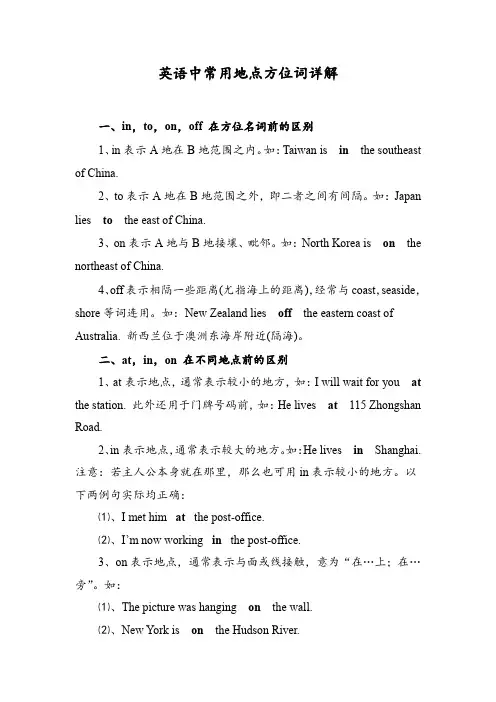
英语中常用地点方位词详解一、in,to,on,off 在方位名词前的区别1、in表示A地在B地范围之内。
如:Taiwan is in the southeast of China.2、to表示A地在B地范围之外,即二者之间有间隔。
如:Japan lies to the east of China.3、on表示A地与B地接壤、毗邻。
如:North Korea is on the northeast of China.4、off表示相隔一些距离(尤指海上的距离),经常与coast,seaside,shore等词连用。
如:New Zealand lies off the eastern coast of Australia. 新西兰位于澳洲东海岸附近(隔海)。
二、at,in,on 在不同地点前的区别1、at表示地点,通常表示较小的地方,如:I will wait for you at the station. 此外还用于门牌号码前,如:He lives at115 Zhongshan Road.2、in表示地点,通常表示较大的地方。
如:He lives in Shanghai. 注意:若主人公本身就在那里,那么也可用in表示较小的地方。
以下两例句实际均正确:⑴、I met him at the post-office.⑵、I’m now working in the post-office.3、on表示地点,通常表示与面或线接触,意为“在…上;在…旁”。
如:⑴、The picture was hanging on the wall.⑵、New York is on the Hudson River.三、near,by,beside,at 表示“在…附近”的区别1、near表示相对的近,实际距离有可能很远。
如:Suzhou is near Shanghai.2、by和beside都表示靠近,实际距离不远,但beside比by更具体地表示出“在…旁边”的意思。
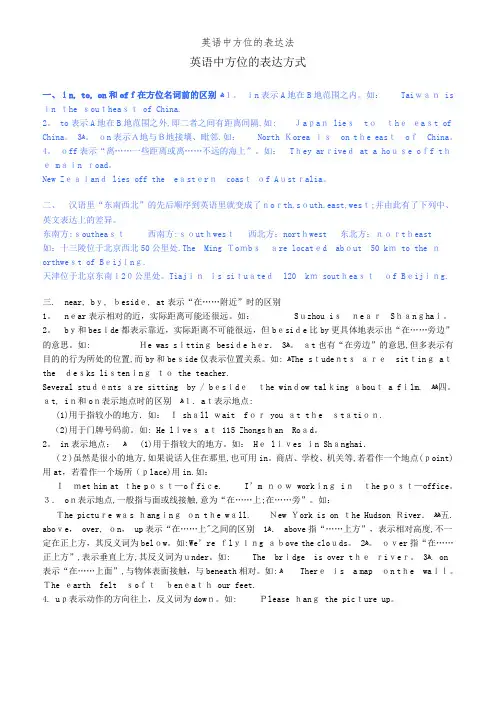
英语中方位的表达法英语中方位的表达方式一、in, to, on和off在方位名词前的区别ﻫ1。
in表示A地在B地范围之内。
如:Taiwan is in the southeast of China.2。
to表示A地在B地范围之外,即二者之间有距离间隔.如: Japan liestotheeast of China。
ﻫ3。
on表示A地与B地接壤、毗邻.如: North Korea ison the eastofChina。
4。
off表示“离……一些距离或离……不远的海上”。
如: They arrived at a house off the main road。
New Zealand lies off the easterncoastof Australia。
二、汉语里“东南西北”的先后顺序到英语里就变成了north,south,east,west;并由此有了下列中、英文表达上的差异。
东南方:southeast西南方:southwest西北方:northwest 东北方:northeast 如:十三陵位于北京西北50公里处.The Ming Tombsare located about 50 km to the northwest of Beijing.天津位于北京东南120公里处。
Tiajinis situatedl20 km southeastof Beijing.三. near, by, beside, at表示“在……附近”时的区别1。
near表示相对的近,实际距离可能还很远。
如:Suzhou isnearShanghai。
2。
by和beside都表示靠近,实际距离不可能很远,但beside比by更具体地表示出“在……旁边”的意思。
如: He was sitting beside her.ﻫ3。
at也有“在旁边”的意思,但多表示有目的的行为所处的位置,而by和beside仅表示位置关系。
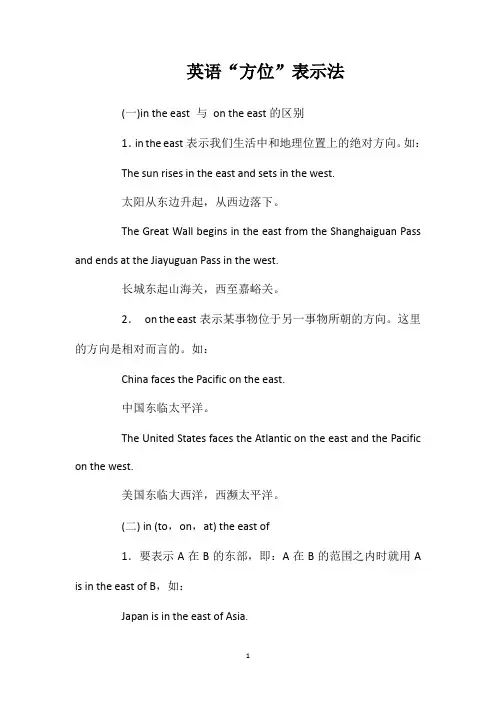
英语“方位”表示法(一)in the east 与on the east的区别1.in the east表示我们生活中和地理位置上的绝对方向。
如:The sun rises in the east and sets in the west.太阳从东边升起,从西边落下。
The Great Wall begins in the east from the Shanghaiguan Pass and ends at the Jiayuguan Pass in the west.长城东起山海关,西至嘉峪关。
2.on the east表示某事物位于另一事物所朝的方向。
这里的方向是相对而言的。
如:China faces the Pacific on the east.中国东临太平洋。
The United States faces the Atlantic on the east and the Pacific on the west.美国东临大西洋,西濒太平洋。
(二) in (to,on,at) the east of1.要表示A在B的东部,即:A在B的范围之内时就用A is in the east of B,如:Japan is in the east of Asia.日本在亚洲东部。
Italy is in the south of Europe.意大利在欧洲南部。
2.如果A在B的东方,即:A在B的范围之外,且相隔有一定的距离,就用A lies to the east of B.口语中有时可将to the省去。
如:Japan lies (to the) east of China.日本位于中国东方。
France lies (to the) east of England.法国位于英国东方。
3.如果A在B的东边(侧),即:A与B相邻接。
就用A is on the east of B.如:Guangdong is on the south of Hunan.广东在湖南南边。
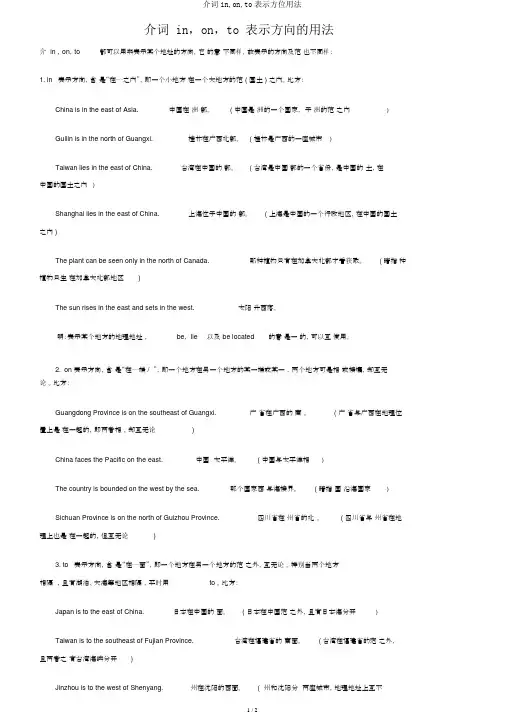
介词 in,on,to 表示方向的用法介 in ,on,to都可以用来表示某个地址的方向,它的意不同样,故表示的方向及范也不同样:1.in 表示方向,含是“在⋯⋯之内”,即一个小地方在一个大地方的范( 国土 ) 之内。
比方:China is in the east of Asia.中国在洲部。
( 中国是洲的一个国家,于洲的范之内) Guilin is in the north of Guangxi.桂林在广西北部。
( 桂林是广西的一座城市)Taiwan lies in the east of China.台湾在中国的部。
( 台湾是中国部的一个省份,是中国的土,在中国的国土之内)Shanghai lies in the east of China.上海位于中国的部。
( 上海是中国的一个行政地区,在中国的国土之内 )The plant can be seen only in the north of Canada.那种植物只有在加拿大北部才看获取。
( 暗指种植物只生在加拿大北部地区)The sun rises in the east and sets in the west.太阳升西落。
明:表示某个地方的地理地址,be, lie以及be located的意是一的,可以互使用。
2.on 表示方向,含是“在⋯⋯端 / ”,即一个地方在另一个地方的某一端或某一,两个地方可是相或接壤,却互无论。
比方:Guangdong Province is on the southeast of Guangxi.广省在广西的南。
( 广省与广西在地理位置上是在一起的,即两者相,却互无论)China faces the Pacific on the east.中国太平洋。
( 中国与太平洋相)The country is bounded on the west by the sea.那个国家西与海接界。
( 暗指国沿海国家) Sichuan Province is on the north of Guizhou Province.四川省在州省的北。

英语中方位的表达法-CAL-FENGHAI.-(YICAI)-Company One1英语中方位的表达方式一、in, to, on和off在方位名词前的区别1. in表示A地在B地范围之内。
如: Taiwan is in the southeast of China.2. to表示A地在B地范围之外,即二者之间有距离间隔。
如: Japan lies to the east of China.3. on表示A地与B地接壤、毗邻。
如: North Korea is on the east of China.4. off表示“离……一些距离或离……不远的海上”。
如: They arrived at a house off the main road.New Zealand lies off the eastern coast of Australia.二、汉语里“东南西北”的先后顺序到英语里就变成了north,south,east,west;并由此有了下列中、英文表达上的差异。
东南方:southeast 西南方:southwest 西北方:northwest 东北方:northeast 如:十三陵位于北京西北50公里处。
The Ming Tombs are located about 50 km to the northwest of Beijing. 天津位于北京东南120公里处。
Tiajin is situated l20 km southeast of Beijing.三. near, by, beside, at表示“在……附近”时的区别1. near表示相对的近,实际距离可能还很远。
如: Suzhou is near Shanghai.2. by和beside都表示靠近,实际距离不可能很远,但beside比by更具体地表示出“在……旁边”的意思。
如: He was sitting beside her.3. at也有“在旁边”的意思,但多表示有目的的行为所处的位置,而by和beside仅表示位置关系。
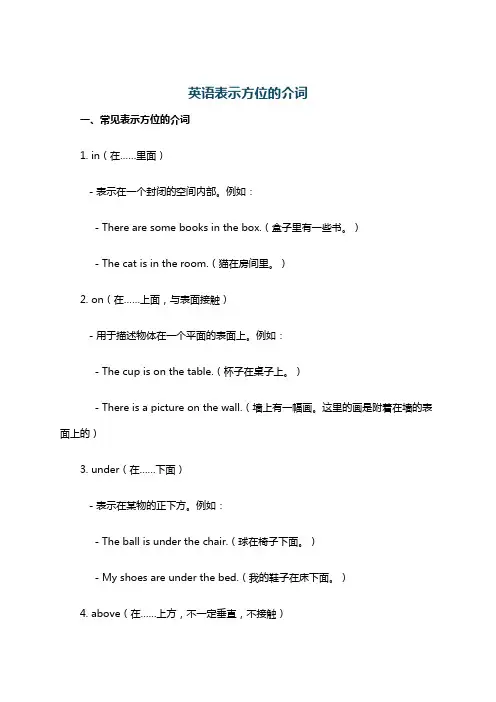
英语表示方位的介词一、常见表示方位的介词1. in(在……里面)- 表示在一个封闭的空间内部。
例如:- There are some books in the box.(盒子里有一些书。
)- The cat is in the room.(猫在房间里。
)2. on(在……上面,与表面接触)- 用于描述物体在一个平面的表面上。
例如:- The cup is on the table.(杯子在桌子上。
)- There is a picture on the wall.(墙上有一幅画。
这里的画是附着在墙的表面上的)3. under(在……下面)- 表示在某物的正下方。
例如:- The ball is under the chair.(球在椅子下面。
)- My shoes are under the bed.(我的鞋子在床下面。
)4. above(在……上方,不一定垂直,不接触)- 强调在某个物体的上方,但不一定是正上方,而且两者不接触。
例如:- The plane is flying above the clouds.(飞机正在云层上方飞行。
)- There is a lamp above the desk.(书桌上方有一盏灯。
)5. below(在……下方,不一定垂直,不接触)- 和above相对,指在某个物体的下方,但不一定是正下方,两者不接触。
例如:- The temperature below the mountain is higher.(山下的温度更高。
) - The fish are swimming below the surface of the water.(鱼在水面下方游动。
)6. beside(在……旁边)- 表示在某物的近旁。
例如:- The boy is standing beside his mother.(男孩站在他妈妈旁边。
)- There is a tree beside the house.(房子旁边有一棵树。
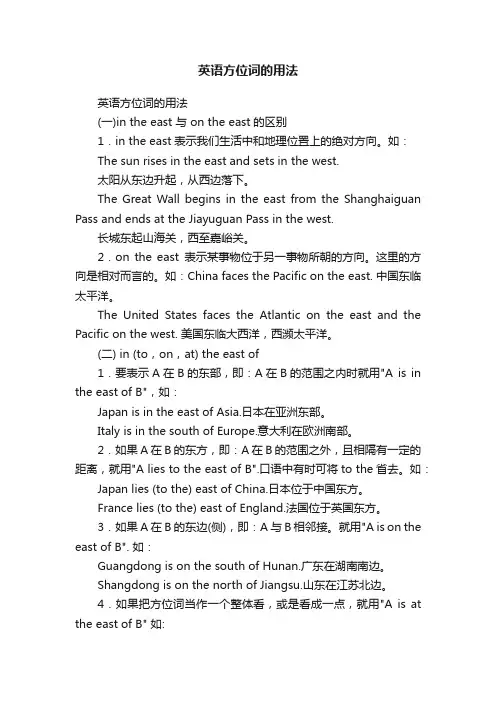
英语方位词的用法英语方位词的用法(一)in the east 与 on the east的区别1.in the east表示我们生活中和地理位置上的绝对方向。
如:The sun rises in the east and sets in the west.太阳从东边升起,从西边落下。
The Great Wall begins in the east from the Shanghaiguan Pass and ends at the Jiayuguan Pass in the west.长城东起山海关,西至嘉峪关。
2.on the east表示某事物位于另一事物所朝的方向。
这里的方向是相对而言的。
如:China faces the Pacific on the east. 中国东临太平洋。
The United States faces the Atlantic on the east and the Pacific on the west. 美国东临大西洋,西濒太平洋。
(二) in (to,on,at) the east of1.要表示A在B的东部,即:A在B的范围之内时就用"A is in the east of B",如:Japan is in the east of Asia.日本在亚洲东部。
Italy is in the south of Europe.意大利在欧洲南部。
2.如果A在B的东方,即:A在B的范围之外,且相隔有一定的距离,就用"A lies to the east of B".口语中有时可将to the省去。
如:Japan lies (to the) east of China.日本位于中国东方。
France lies (to the) east of England.法国位于英国东方。
3.如果A在B的东边(侧),即:A与B相邻接。
就用"A is on the east of B". 如:Guangdong is on the south of Hunan.广东在湖南南边。
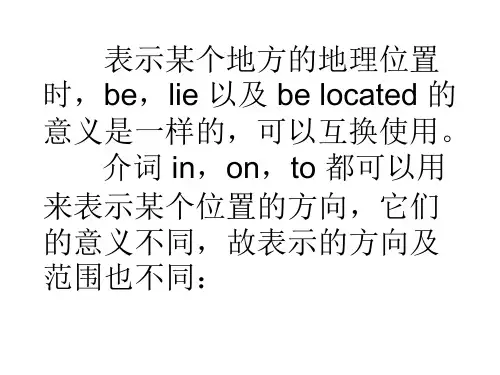
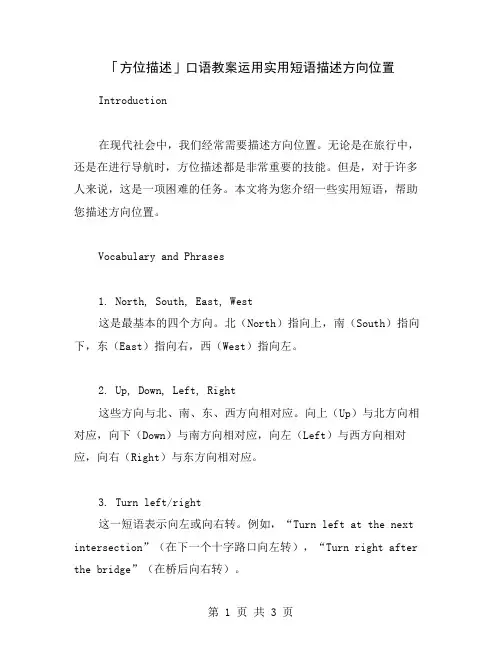
「方位描述」口语教案运用实用短语描述方向位置Introduction在现代社会中,我们经常需要描述方向位置。
无论是在旅行中,还是在进行导航时,方位描述都是非常重要的技能。
但是,对于许多人来说,这是一项困难的任务。
本文将为您介绍一些实用短语,帮助您描述方向位置。
Vocabulary and Phrases1. North, South, East, West这是最基本的四个方向。
北(North)指向上,南(South)指向下,东(East)指向右,西(West)指向左。
2. Up, Down, Left, Right这些方向与北、南、东、西方向相对应。
向上(Up)与北方向相对应,向下(Down)与南方向相对应,向左(Left)与西方向相对应,向右(Right)与东方向相对应。
3. Turn left/right这一短语表示向左或向右转。
例如,“Turn left at the next intersection”(在下一个十字路口向左转),“Turn right after the bridge”(在桥后向右转)。
4. Go straight/continue straight这一短语表示继续直行。
例如,“Go straight for three blocks”(直走三个街区),“Continue straight until you reach the intersection”(一直走到你到达十字路口)。
5. U-turn这表示掉头或返回。
例如,“Make a U-turn at the nexttraffic light”(在下一个红绿灯处掉头)。
6. Intersection交叉口。
例如,“Turn right at the intersection”(在交叉口向右转)。
7. Roundabout/traffic circle这是一个交通环岛,而且比较普遍出现在许多国家中。
有些人可能会称其为“转盘”或“环状公路”。
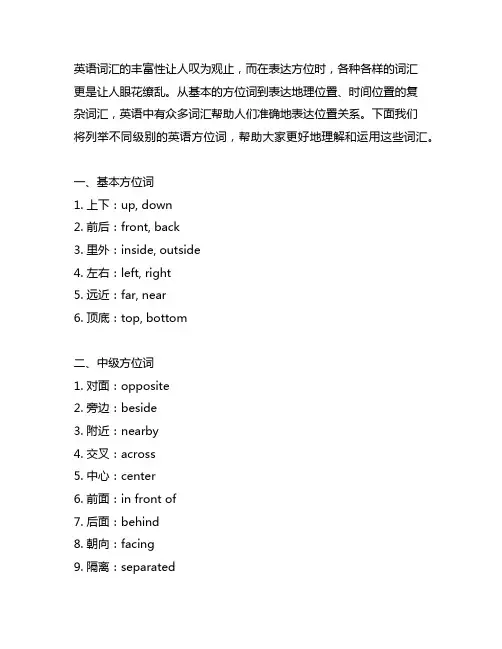
英语词汇的丰富性让人叹为观止,而在表达方位时,各种各样的词汇更是让人眼花缭乱。
从基本的方位词到表达地理位置、时间位置的复杂词汇,英语中有众多词汇帮助人们准确地表达位置关系。
下面我们将列举不同级别的英语方位词,帮助大家更好地理解和运用这些词汇。
一、基本方位词1. 上下:up, down2. 前后:front, back3. 里外:inside, outside4. 左右:left, right5. 远近:far, near6. 顶底:top, bottom二、中级方位词1. 对面:opposite2. 旁边:beside3. 附近:nearby4. 交叉:across5. 中心:center6. 前面:in front of7. 后面:behind8. 朝向:facing9. 隔离:separated10. 周围:around三、高级方位词1. 上方:above2. 下方:below3. 左上方:upper left4. 右下方:lower right5. 正上方:directly above6. 倾斜:inclined7. 水平:horizontal8. 垂直:vertical9. 天花板:ceiling10. 地板:floor四、地理位置词1. 东:east2. 西:west3. 南:south4. 北:north5. 中部:central6. 极地:polar7. 大陆:continent8. 岛屿:island9. 沿海:coastal10. 内陆:inland五、时间位置词1. 早上:morning2. 中午:noon3. 下午:afternoon4. 晚上:evening5. 夜间:night6. 黎明:dawn7. 傍晚:dusk8. 黄昏:twilight9. 日出:sunrise10. 日落:sunset以上便是英语中常用的各种方位词,它们帮助人们准确地描述位置关系,无论是日常生活中还是学术交流中都发挥着重要作用。
初中英语语法总结:方位介词(有答案)A。
XXX初中英语语法总结:方位介词方位介词用于描述物体或人在空间中的位置关系,常见的有in、on、behind、next to、near、over、under等。
1.in表示在某个物体内部,如XXX可以改为XXX XXX XXX.2.on表示在某个物体的表面,如There are some apples on the tree.可以改为The apples are on the surface of the tree.3.under表示在某个物体的下面或正下方,如What's under your desk?可以改为XXX?4.over表示在某个物体的正上方,如There is a shelf over the table.可以改为There is a shelf above the table.5.XXX表示在某个物体的斜上方,如Raise your arms above your head.可以改为Lift your arms at an angle above your head.6.below表示在某个物体的斜下方,如XXX可以改为XXX.7.XXX表示在某个物体的后面,如There XXX.可以改为There is a bike at the back of the tree.8.XXX表示在某个物体的旁边,如There is a café next to the barber's.可以改为There is a café beside the barber's.9.near表示在某个物体的附近,如My bed is near the window.可以改为My bed is close to the window.XXX表示在某个物体的旁边,如He was XXX.可以改为He was sitting next to the window.练:1.XXX passing ___ the bridge.A。
方位、地点介词的用法辨析大全易混淆的介词都分门别类好啦!方位介词on, over, above(A) on表示一物放在另一物上面,两者紧贴在一起,如:The book is on the table.(B) over表示一种垂直悬空的上下关系,即“在…上方”,如:Is there any bridge over the river?(C) above表示一般的“高于…”,“在…之上”,不一定在正上方,如:There was an electric clock above his bed.方位介词under,below(A)under是over的反义词即“在…下方”,如:They were seen under the tree.(B)below是above的反义词即“低于…”,“在…之下”,如:They live below us.方位介词across,through,over,past(A) across着重于“从一头或一边到另一头或另一边”,强调从表面穿过。
如:She went across the street to make some purchases.(B) through着重于“穿越”,强调从一定的空间内穿过。
如:The sunlight was coming in through the window.(C) over多表示从“上方越过”,如:He failed to go over the mountain; he had to go round it.(D) past表示从“面前经过”,如:Someone has just gone past the window.方位介词in,on,at(A) in表示“排、行、组”,如:We are in Team One.(B) on表示“左、右”,如:Li Ping is on my left.(C) at表示“前、后”,如:I sit at the front of the classroom.方位介词to,for(A) 介词to表示目的地或去的目的,如:Will you take a train to Tianjin.(B) 介词for表示动身去某地,如:He got on a train for Shanghai.方位介词in front of, in the front of(A) in front of 表示在某人或某物的前面,在某个范围以外。
英语中的东南西北用法要点1. 其前通常加 the;表示在某个方位,通常介词 in。
如:He lives in the south (north). 他住在南(北)方。
The sun rises in the east and sets in the west. 太阳从东方升起,从西方落下。
【注】有时也不用冠词(尤其是表示纯方位或进行反义对比时)。
如:I’m lost; which direction is south? 我迷路了,哪边是南?South is opposite north on a compass. 罗盘上南与北相对。
East or west, home is best. 东好西好不如自己的家好。
2. 表示“在……的东(南,西,北)”,通常应根据情况选用不同介词in(表示在范围之内),to(表示在范围之外),on(表示毗连)。
如:China is in the east of Asia. 中国位于亚洲的东部。
Mexico is to the south of the U. S. A. 墨西哥在美国以南。
China faces the Pacific on the east. 中国东临太平洋3. 用作副词,其前不用介词,但有时其后可接介词短语。
如:The room faces east, so we get the morning sun. 这房间朝东,所以我们上午能照到太阳。
The village lies east of the woods. 村庄位于树林东面。
比较:The village lies to the east of the woods.有的词书把 east of 之类的结构当作固定短语看待,将其用作表语、状语或后置定语等。
如:Is the Atlantic Ocean east or west of the United States?大西洋是在美国的东面还是西面? The Smiths live (five miles) southeast of the town. 史密斯一家住在城镇东面(五英里的地方)。
英语基本方位英语基本方位英语是世界上最为广泛使用的语言之一,了解它的方位词可以有效地帮助我们描述事物的方位和位置。
下面将介绍英语中常用的方位词以及它们在表达中的用法。
一、地理方位1. North(北):常用于提及地理位置例如:Beijing is located in North China. (北京位于中国北部。
)2. South(南):与北相反,常用于描述地理位置例如: The Sichuan Province is located in South-Western China. (四川省位于中国西南部。
)3. East (东): 用于描述东方地区例如:Japan is located in East Asia.(日本位于亚洲东部。
)4. West(西):与东相反,用于描述西方地区例如:The United States of America is located in Western Hemisphere.(美国位于西半球。
)二、相对方位1. Up(向上):表示高处或上升方向例如:I am going up the stairs.(我正在上楼。
)2. Down(向下):表示低处或下降方向例如:I am going down the hill.(我正在下山。
)3. Left(向左):表示左边方向例如:The school is on the left side of the road.(学校在这条路的左侧。
)4. Right(向右):表示右边方向例如:The supermarket is on the right side of the road.(超市在这条路的右侧。
)5. Inside(内部):表示在物体内部例如:I put the book inside the bag.(我把书放到包里了。
)6. Outside(外部):表示物体的外部例如:The flowers are outside the door.(花卉在门外。
in the的用法区别一、介词in的基本意义及用法介词in是英语中最常见的介词之一,它有多种意义和用法。
下面将从空间方位、时间、状况和动作方式几个方面来讨论in的用法。
1. 空间方位在空间方位上,in表示位置或被围绕。
例如:(1) He is in the room.(他在房间里。
)(2) The books are in the bookshelf.(书在书架上。
)除了表示位置,in还表示某物所处的范围。
例如:(3) She is in her twenties.(她二十几岁。
)2. 时间在时间上,in通常与具体月份、季节和年代连用。
例如:(1) I was born in October.(我生于十月。
)(2) We will go swimming in summer.(我们夏天去游泳。
)此外,在表示几点钟时,也使用介词in。
(3) The meeting will start at quarter past ten in the morning.(会议将于上午十点一刻开始。
)3. 状况在描述状况时,in表达事物所处的状态或情况:(1) She is in good health now.(她现在身体很健康。
)(2) The dog is in a deep sleep.(那只狗正在沉睡中。
)4. 动作方式in也可以表示某种动作的方式。
例如:(1) He walked in silence.(他默默无言地走着。
)(2) She ate the cake in one bite.(她一口吃掉了蛋糕。
)综上所述,介词in在空间方位、时间、状况和动作方式等方面都有广泛的应用。
二、the与in的用法区别1. 用法不同the是定冠词,用于特指某人或某物,表示“那个”、“这个”、“该”的意思。
而in是介词,在句子中主要表示位置、范围和方式等概念。
2. 出现位置不同the通常出现在名词之前,限定特定事物或人。
用英语介绍地理位置和地方的句型Ⅰ. 可能会用到的词汇、短语及相关知识:across, border, continent, face (v), landmark, lie, locate, mountain range, situate运用描述地方的用语:in, on, between, in the middle of, on the coast of, off the coast of, on the left, on the right, in front of, behind, near, next to, opposite, above, below, in the south of, to the east of特别是几个介词的用法, 以east 为例, 方位表示方法如下:(一) in the east表示我们生活中和地理位置上的绝对方向,如The sun rises in the east andsets in the west.(二) on the east 表示某事物位于另一事物所朝的方向,这里的方向指相对,如China facesthe Pacific on the east.(三)in\to\on\at the east of1、A在B范围之内,要表示A在B的东部,用A is in the east of B2 、A在B范围之外,要表示A在B的东方,用A lies to the east of B3、A与B相接,要表示A在B的东侧,用A is on the east of B4、如果把方位词看作一个整体,或者看成一地点,,就用A is at the east ofB ,如: there was a big battle at the north of the liaodong peninsula. 在辽东半岛的北边有一场大战5、如果表示A位于B东面100公里处,既可以说A lies 100km to the east of B, 又可以说A lies 100km east of B(四)要表示方位"偏向"通常用by,如正南偏东:south by eastⅡ. 例子:(一)以中国为例ChinaThe People’s Republic of China is a socialis t country with its own characteristics. It is one of the developing countries. China lies in the east of Asia. It has a number of neighboring countries. To the north, northeast and northwest are the Mongolia, Russia and Korea. To the south are Vietnam, Laos, Thailand and the Philippine. To the west and southwest are India, Burma, Bhutan, Nepal and Pakistan. To the east is Japan, which faces China across the East China Sea. China is a country with a vast territory. It has an area of over 9,600,000 square kilometers. It consists of 34 provinces, autonomous regions, and municipalities directly under the Central Covernment. Beijing, which is situated in the North China, is its capital. The People’s Republic of China is one ofthe largest countries in the world. Now it has a population of more than 1.3 billion, making up a quarter of the world population.以下是汉字部分:①华人民共和国是一个有中国特色的社会主义国家。